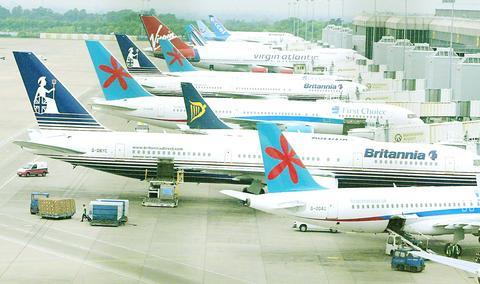A computer failure at a British air traffic control center grounded many of the country's flights yesterday morning.
The National Air Traffic Service said its computer system went down at about 6am, halting flights at airports across the country. The system was running again two hours later, but airports said the backlog of flights would cause delays throughout the day.
"Our computer system is now fully operational and safety being our primary concern we are now working to make sure those aircraft in the air and in need of landing should be able to do so to clear the delays," said air traffic spokesman Adrian Yalland.

PHOTO: AP
He said the fault was believed to be located at an operations center in West Drayton, near Heathrow Airport.
All flights were suspended at Heathrow, Britain's busiest airport. An airport spokesman said departing flights were facing delays of between one and two hours.
At Gatwick, flights were landing normally but departures were operating "in a very restricted flow rate," a spokesman said.
Delays were running at two or three hours early yesterday at Stansted Airport north of London, a major hub for budget airlines connecting Britain and the European continent.
At Manchester airport, a spokeswoman said flights were grounded for about an hour but began to resume around 7am. However, delays continued because of a backlog.
British Airways said there would be "severe delays throughout the day."
The air traffic service has been beset by problems since it was partially privatized in 2001. A US$484 million center at Swanwick in southern England opened five years late in 2002.
The opening was delayed by problems with computer software, and the glitches continued for months afterward, as controllers misread aircraft altitudes and destinations because of hard-to-decipher computer screens.

A fire caused by a burst gas pipe yesterday spread to several homes and sent a fireball soaring into the sky outside Malaysia’s largest city, injuring more than 100 people. The towering inferno near a gas station in Putra Heights outside Kuala Lumpur was visible for kilometers and lasted for several hours. It happened during a public holiday as Muslims, who are the majority in Malaysia, celebrate the second day of Eid al-Fitr. National oil company Petronas said the fire started at one of its gas pipelines at 8:10am and the affected pipeline was later isolated. Disaster management officials said shutting the

US Vice President J.D. Vance on Friday accused Denmark of not having done enough to protect Greenland, when he visited the strategically placed and resource-rich Danish territory coveted by US President Donald Trump. Vance made his comment during a trip to the Pituffik Space Base in northwestern Greenland, a visit viewed by Copenhagen and Nuuk as a provocation. “Our message to Denmark is very simple: You have not done a good job by the people of Greenland,” Vance told a news conference. “You have under-invested in the people of Greenland, and you have under-invested in the security architecture of this

Japan unveiled a plan on Thursday to evacuate around 120,000 residents and tourists from its southern islets near Taiwan within six days in the event of an “emergency”. The plan was put together as “the security situation surrounding our nation grows severe” and with an “emergency” in mind, the government’s crisis management office said. Exactly what that emergency might be was left unspecified in the plan but it envisages the evacuation of around 120,000 people in five Japanese islets close to Taiwan. China claims Taiwan as part of its territory and has stepped up military pressure in recent years, including

UNREST: The authorities in Turkey arrested 13 Turkish journalists in five days, deported a BBC correspondent and on Thursday arrested a reporter from Sweden Waving flags and chanting slogans, many hundreds of thousands of anti-government demonstrators on Saturday rallied in Istanbul, Turkey, in defence of democracy after the arrest of Istanbul Mayor Ekrem Imamoglu which sparked Turkey’s worst street unrest in more than a decade. Under a cloudless blue sky, vast crowds gathered in Maltepe on the Asian side of Turkey’s biggest city on the eve of the Eid al-Fitr celebration which started yesterday, marking the end of Ramadan. Ozgur Ozel, chairman of the main opposition Republican People’s Party (CHP), which organized the rally, said there were 2.2 million people in the crowd, but